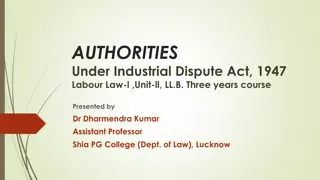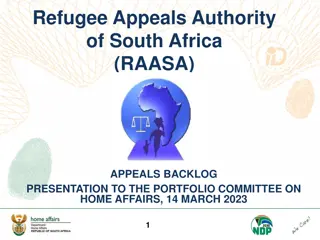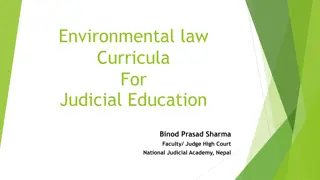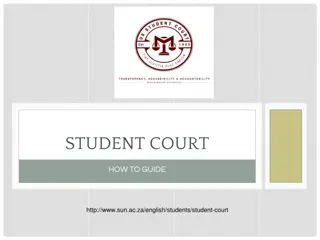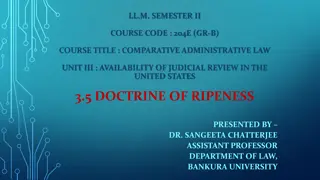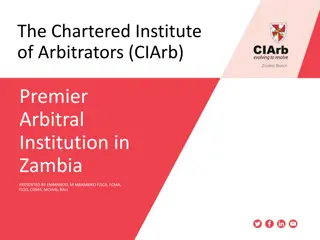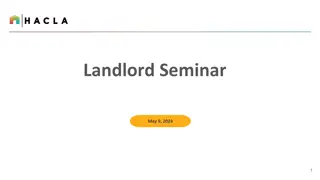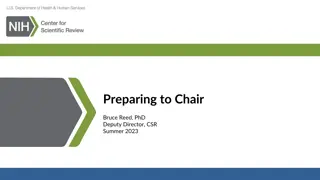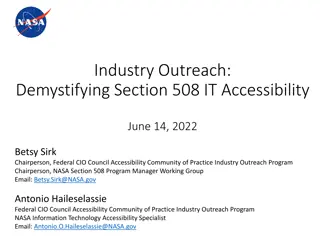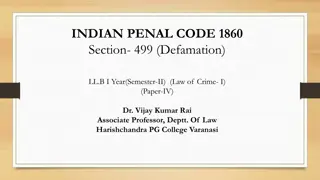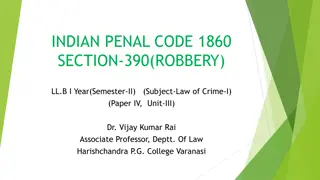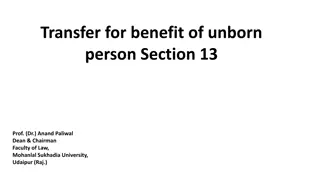Section 44 Process in Immigration Adjudication
The process from allegation to adjudication in immigration cases involves Section 44 referrals, MDRs, and admissibility hearings under IRPA. Officers have discretion to write reports or issue removal orders based on inadmissibility opinions. Procedural fairness is essential, including providing detailed disclosure and opportunities for response to allegations. Recent case law emphasizes the right to disclosure and fair treatment for individuals involved in the process.
Download Presentation

Please find below an Image/Link to download the presentation.
The content on the website is provided AS IS for your information and personal use only. It may not be sold, licensed, or shared on other websites without obtaining consent from the author. Download presentation by click this link. If you encounter any issues during the download, it is possible that the publisher has removed the file from their server.
E N D
Presentation Transcript
From Allegation to Adjudication (s.44 referrals, MDRs and admissibility hearings) CARL Webinar Series September 2020 Presented by: Ali Esnaashari, J.D.
Section 44 Process Alleged Section 44(1) Section 44(2) Admissibility Hearing/ Incident Report Referral Removal Order Sections 44(1) and (2) of IRPA provide officers discretion to elect not to write a report, under s.44(1), or to not refer the report/issue a removal order, under s. 44(2). The process is often initiated by a Procedural Fairness letter from CBSA/IRCC, inviting the person concerned to provide evidence/submissions about inadmissibility. 15 to 30 days to respond. Request an extension if needed.
S. 44(1) Report Operation Manual ENF 05 : All A44(1) reports must: Contain the complete name of the person being reported; (p.41) Contain the exact subsection(s)/paragraph(s) of the IRPA (and IRPR, if applicable) upon which the officer based his/her opinion; P. 41 Include a narrative that justifies the inadmissibility opinion and cites the facts upon which that opinion is based. (p. 41 ) In all cases, and especially in those cases where the sections of the Act are not specific in themselves, indicate the exact grounds for applying the particular inadmissibility section(s) . (p. 16).
Right to Disclosure Information must be material and previously unknown and unavailable: Sharma 2016 FCA 319 at para 34: Para 34: To the extent that the person is informed of the facts that have triggered the process is given the opportunity to present evidence and to make submissions, is interviewed after having been told of the purpose of that interview and of the possible consequences, is offered the possibility to seek assistance from counsel, and is given a copy of the report before the admissibility hearing, the duty of fairness will have been met. Velimirovic v. Canada (Citizenship and Immigration), 2019 FC 1156 at para 20: The decision-maker incorporated a significant amount of the NSSD s recommendations without permitting Mr. Velimirovic a meaningful opportunity to reply. The two-page fairness letter did not adequately capture the content of the nine-page NSSD report. Had more detailed information about the report been provided to Mr. Velimirovic, he could have presented very relevant information on the credibility issues raised and the proper application of the Ezokola factors. Hosseini v. Canada (Immigration, Refugees and Citizenship), 2018 FC 171 at para 25: Providing a vague reference to Mr. Hosseini s possible inadmissibility on security grounds was insufficient to satisfy the officer s duty of fairness. Mr Hosseini was entitled to know what allegations had been made against him and what evidence was relied on to support those allegations.
Right to Disclosure Durkin v. Canada (Public Safety and Emergency Preparedness), 2019 FC 174; J. Barnes: [29] It strikes me as implausible that Mr. Durkin needed any information from the CBSA to understand the scope and nature of the criminal case against him. Even if he was not privy to this information as events were unfolding (a doubtful proposition at best), much of the information he says he needed would have been publicly available most notably the decision of the United States Court of Appeals involving the three co-accused. Simple queries to obvious sources in Alabama would also have produced what he says he needed. [30] In the absence of clear and unequivocal evidence from Mr. Durkin that he was honestly unaware of the substance of the criminal allegations against him and his convicted associates, I draw an inference that he knew full well (or had the means to know) about that aspect of the CBSA s case. I do not accept his argument that he was blind to that evidence; and, even if he was, it was a case of strategic willful blindness. In either situation, the CBSA owed him no duty of additional disclosure.
Right to Disclosure Jeffrey v. Canada (Public Safety and Emergency Preparedness), 2019 FC 1180, by CJ Crampton: [34] The only disclosure obligation to which the Officer was subject was to disclose information that is material and otherwise unknown and unavailable to Mr. Jeffrey. The Minister maintains that no such information exists. Mr. Jeffrey has not demonstrated the contrary. Therefore, he has not established that his procedural fairness rights were breached [36] Notwithstanding the foregoing, like Justice Barnes in Durkin, above, at para 31, I question the wisdom of the Officer s refusal to disclose any information whatsoever to Mr. Jeffrey. [ ] However, it is reasonable to expect that the significant cost and administrative burden associated with proceedings before this Court could be avoided where the essence of the officer s concern is conveyed to the individual, so that they have a better sense of what has given rise to the officer s concern. Implicit in this is that the individual would then be in a position to make more meaningful submissions to the CBSA officer. In this case, a basic explanation of why the Officer believed that Mr. Jeffrey may have been a member of the Taliban may have avoided the considerable time and effort that has been spent by the parties and the Court in relation to this proceeding.
Right to Disclosure Does the case involve security assessments, CSC report, CSIS report, poison-pen letter? Request disclosure of documents or at least a list of documents. Unable to provide meaningful response due to inadequate disclosure? State that in your response and outline unsuccessful effort to obtains documents. Highlight FC s commentary about unreasonableness of refusing readily available evidence/information (Durkin and Jeffrey).
Responding to s. 44(1) Report Whether to respond or not? Consider the ground of inadmissibility, disputing the allegation or not, status of PC (FN or PR), access to IAD or not. Information to include on response: If serious criminality: focus on rehab, recidivism and danger to the public more than ever before. H&C Submissions: BIOC, adverse country conditions, establishment etc. Request not to render a decision: long-term offenders, criminal appeal pending, etc.
Hernandez to McAlpin The collapse of discretion in s. 44 proceedings Hernandez (2005 FC) and Cha (2006 FCA): Officers, depending on the circumstances have discretion to consider H&Cs in preparing and referring s. 44 reports. Faci J Russel (2011 FC 693): MD may have some discretion to consider humanitarian and compassionate factors but that the decision under subsection 44(2) is not a full- blown humanitarian and compassionate review. The general consensus seems to be that the Act provides opportunities elsewhere for the applicant to raise H&C issues. Fabbiano J O'Reilly (2014 FC 1219): Minister s role is to consider evidence relevant to admissibility may include H&Cs (Particularly for long-term PRs). Balan J Montigny(2015 FC 691): Minister s discretion is relatively narrow under section 44, if only because paragraph 36(1) (a) does not call for much judgment in its implementation. Bermudez 2016 FCA 131: Confirms narrowing scope of discretion since Hernandez: Para 44 (No pun intended): Also, a number of decisions post Hernandez, including decisions involving permanent residents, have tended to significantly narrow the discretion contemplated at section 44 of the IRPA in Hernandez[ ]
Hernandez to McAlpin The collapse of discretion in s. 44 proceedings Melendez J Boswll (2016 FC 1363): Acknowledges contradictory caselaw on s. 44 discretion: There is conflict about degree of discretion Jurisprudence and manual suggest discretion though limited to consider H&Cs. Discretion but no obligation. But if they are presented and rejected by officer, reasons for rejection should be stated even briefly. Not a full-blown s. 25 analysis. Sharma 2016 FCA 319 (10 years after Cha). Security is top priority (In context of s. 36). PRs arguably have greater participatory rights. Discretion may vary depending on the ground of inadmissibility and whether PR/FN. The Manual requires Officer to consider personal circumstances of PC, which suggests officers are not constrained by the mere verification of a conviction and/or term of imprisonment. Scope of Officer s discretion? Let s leave this issue is for another day
Hernandez to McAlpin The collapse of discretion in s. 44 proceedings Abdi (2017 FC 950) J Southcott: No ruling on scope of discretion, but affirms that recent caselaw suggests that MD has discretion to consider H&Cs, particularly to consider factors in manual, as confirmed in Sharma. McAlpin - (2018 FC 422) CJ Crampton: Public security and rehab are top priority. Para 65: As a result, it would ordinarily be reasonably open to an officer or a ministerial delegate to prioritize public safety and security, even to the point of entirely refraining from taking H&C factors into account in stating the rationale for a decision to refer someone for an admissibility hearing. Not appropriate to conduct s. 25 or s. 112 analysis and assessment under s. 44(1). Officer can list H&C factors, and even if they conduct H&C analysis and assessment, as long as H&Cs are not relied on for recommendation and rationale , it can be assumed they were not relied on:
Hernandez to McAlpin The collapse of discretion in s. 44 proceedings McAlpin Cont: Officer can list H&C factors, and even if they conduct H&C analysis and assessment, as long as H&Cs are not relied on for recommendation and rationale , it can be assumed they were not relied on: [81] In the narrative report which forms part of the Delegate s decision, the officer listed, in a very general way, a number of H&C considerations and other personal information pertaining to Mr. McAlpin. That was done in section 7 of the assessment form, under the heading Humanitarian and Compassionate Factors and Other Information. [ ] [82] However, in section 9 of the assessment form, under the heading Recommendation and rationale, the officer made no mention whatsoever of those or other H&C considerations in articulating the rationale for his recommendation that Mr. McAlpin be referred to an admissibility hearing. It can reasonably be inferred from the absence of any discussion of H&C considerations in the latter section of the officer s initial Recommendation, that the officer exercised his discretion to not take such considerations into account in making that recommendation. CJ believes the higher courts need to provide more clarity: [112] In my view, the issue of the scope of the discretion contemplated by subss. 44(1) and (2) is a serious question of general importance. Indeed, the FCA has intimated as much: Sharma, above, at para 48; Cha, above, at para 41. The divergence in the jurisprudence of this Court with respect to this issue is also reflective of the seriousness of the question.
Hernandez to McAlpin The collapse of discretion in s. 44 proceedings Lin J. Barnes (2019 FC 862): Further narrowing of s. 44(1)(2) scope. This a screening exercise , and no rationale for treating PRs and FN differently [16] Neither the Officer nor the Delegate is authorized or required to make findings of fact or law. They conduct a summary review of the record before them on the strength of which they express non-binding opinions about potential inadmissibility. This is no more than a screening exercise that triggers an adjudication. It is at the adjudicative stage where controversial issues of law and evidence can be assessed and resolved. [18] Although the Court in Cha, above, was careful to limit the application of its reasons to cases involving foreign nationals I cannot identify a rational basis to extend a more generous substantive discretion to permanent residents under s 44. I accept that greater due process requirements may apply to permanent residents [...] s. 44 treats foreign nationals and permanent residents alike. Accordingly, whatever the basis of inadmissibility may be, the discretion not to make a referral to the ID is the same for both classes. [20] For these reasons I conclude that the scope of discretion available to the Applicants in these cases is no greater than that described in Cha, above, which is to say that aggravating and disputed mitigating circumstances are effectively off the table. Certified Question issued: What is the scope of discretion afforded by s 44 of the IRPA to refer the case of a permanent resident to the Immigration Division for an admissibility hearing on the ground of misrepresentation under s 40 and was that discretion properly exercised in these cases?
Hernandez to McAlpin The collapse of discretion in s. 44 proceedings McLeish J. Kane (2020 FC 705): Follows Lin and McAlpin. Unless Officer cites H&C under the heading Rational for Recommendation , it is presumed the Officer refused to consider them, which they are permitted to do. Basically, H&C analysis can be deficient, unreasonable etc, unless they are done under the recommendation heading. [85] The Officer s approach appears to be similar to that described in McAlpin. In McAlpin, at paras 80 the Chief Justice noted that the Officer listed H&C considerations and other personal information under the heading Humanitarian and Compassionate Factors and Other Information , but that these considerations were not mentioned in the rationale.
Hernandez to McAlpin The collapse of discretion in s. 44 proceedings Slemko J. Walker(2020 FC 718): MDR s decision unreasonable because in the reasons for refusal, MDR noted no letters of familial support , which is an H&C consideration, but then it did not note all the important H&C factors that had been raised by PC. Where do we stand? Rights of PRs and FN under s. 44 are evaporating, particularly following Sharma in the past of couple of years. CBSA s manuals have a broader interpretation of discretion under s. 44 than the FC. Focus is now on public safety and security, to the exclusion of H&Cs. The Reasons for Recommendation is all that matters. FC is pleading for clarification on the scope of discretion and every time FCA has the opportunity, they leave it for another day .
In-Person MDRs Before the Interview Canvass Risk & Potential Refugee Claim; Explain the MDR process to the client; Read the report with client and note any inaccuracies; Interpreter needed? Tell the client to dress for the occasion.
Whats the plan? Provide written submissions and supporting evidence for consideration. Requesting an Allowed to Leave ? Provide explanation for circumstances that led to violation of the Act, client s history of compliance and why everybody would be better off . Client not eligible for PRRA yet? Produce evidence of risk and H&Cs for officer to consider. Show up with a package. Sponsorship Application in Process? Bring proof, H&C submissions if applicable.
Whats the plan? Entrance 93 vs 91. Anticipate the Officer s concerns and directly address them: Delay in removal? Public safety issues? PC must learn ? Highlight the absurdities and inefficiencies if removal order issued and enforced. Is this the best use of resources? Allow your client to play an active role. Never stop advocating.


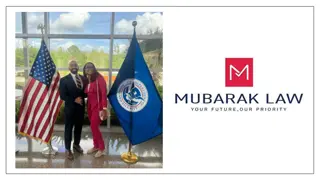
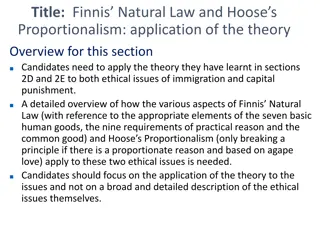
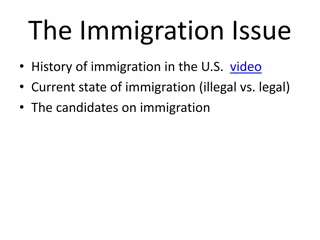
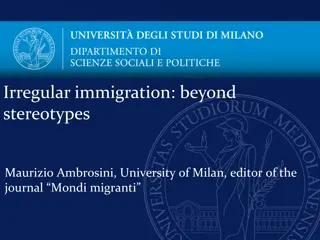
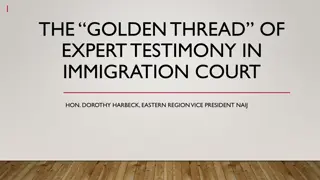
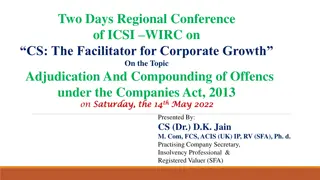
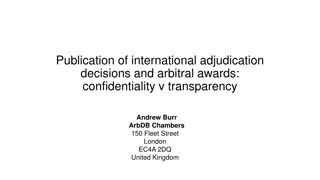
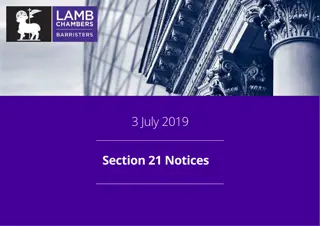
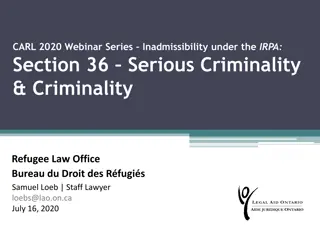

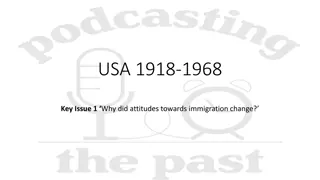

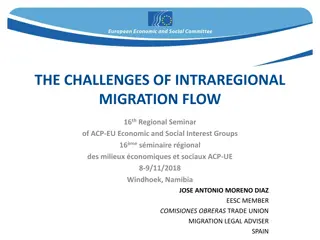
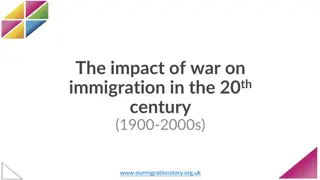
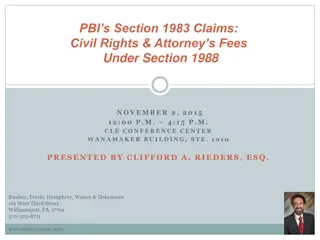

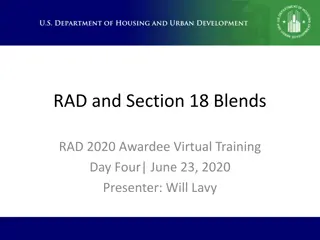
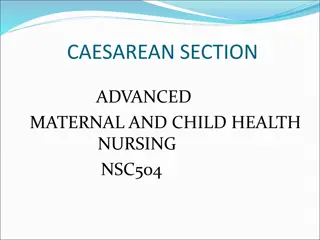
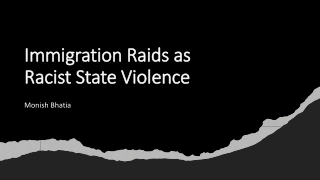

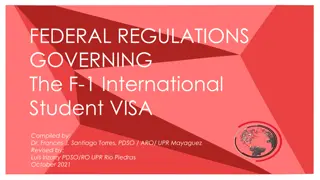
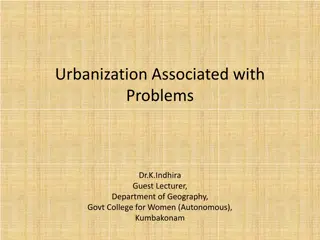

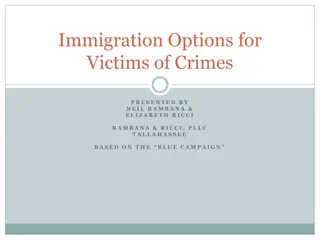
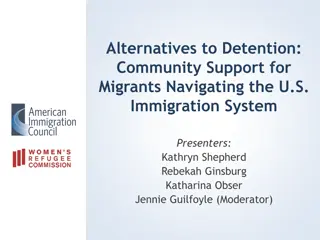


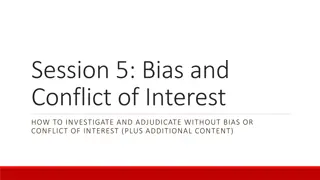

![Prevention and Combating of Hate Crimes and Hate Speech Bill [B.9B.2018]](/thumb/60513/prevention-and-combating-of-hate-crimes-and-hate-speech-bill-b-9b-2018.jpg)

